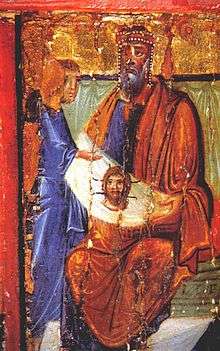Definify.com
Definition 2025
acheiropoieton
acheiropoieton
English

A 10th-century encaustic painting from Saint Catherine's Monastery in Saint Catherine, Egypt, depicting King Abgar of Edessa receiving the Image of Edessa or mandylion, an acheiropoieton
Noun
acheiropoieton (plural acheiropoieta)
- (chiefly Eastern Orthodoxy) An image of Christ believed not to have been created by human hands; a miraculous representation of Jesus.
- 1995, Maurits Smeyers, “An Eyckian Vera Icon in a Bruges Book of Hours, ca. 1450 (New York, Pierpoint Morgan Library, Ms 421)”, in Werner Verbeke [et al.], editors, Serta Devota in Memoriam Guillelmi Lourdaux. Pars Posterior: Cultura Mediaevalis (Mediaevalia Lovaniensia; Series I, Studia XXI), Leuven: Leuven University Press, OCLC 978-90-6186-692-3, page 199:
- These legends not only established the value of the Mandylion and the Vera Icon as authentic portraits of Christ, but also as acheiropoieta, i.e., images made without the intervention of human hands.
- 2003, Gauvin A[lexander] Bailey, Between Renaissance and Baroque: Jesuit Art in Rome, 1565–1610, Toronto: University of Toronto Press, ISBN 978-0-8020-3721-3, page 10:
- An example of an acheiropoieton, or image made without human hands, the icon and its copies alike were believed to possess miraculous qualities that aided spiritual conversion.
- 2009, Diarmuid MacCulloch, A History of Christianity: The First Three Thousand Years, London: Allen Lane, ISBN 978-0-7139-9869-6; republished London: Penguin Books, 2010, ISBN 978-0-141-02189-8, page 452:
- The special nature of Orthodox icons was emphasized by the growth of a notion, much encouraged by these bitter disputes, that there was one quite exceptional class of art: acheiropoieta, images of Jesus not made by human hands, the archetype of which was the now-mysterious Mandylion given by Christ himself to King Abgar of Edessa […].
-
Translations
image of Christ believed not to have been created by human hands
|
|